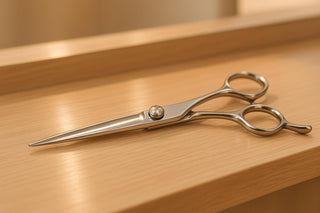Japanese steel shears are precision tools designed for professional hairstylists. Their sharpness, durability, and ergonomic design make them ideal for creating clean, accurate cuts. Here's why they stand out:
- Material Quality: Made from high-carbon steel alloys like VG-10, ATS-314, and ZA-18, these shears maintain sharp edges for longer periods and resist corrosion.
- Sharpness and Precision: The blades are engineered for clean cuts, reducing hair damage and split ends.
- Ergonomic Design: Lightweight with features like offset handles and finger rests, they reduce hand fatigue and improve control during extended use.
- Versatility: Available in various sizes (e.g., 5.5-inch for detailed work, 6.0-6.8-inch for broader cuts), they suit different cutting techniques and hair types.
- Durability: Resistant to wear and environmental factors, these shears are a long-term investment for stylists.
For hairstyling that demands accuracy, such as layered or uneven styles, Japanese steel shears provide the control and consistency needed to achieve professional results. Their combination of sharpness, comfort, and reliability makes them a trusted choice in salons.
Key Properties of Japanese Steel for Precision Cutting
Japanese steel shears bring together advanced material science, thoughtful design, and lasting durability to deliver unmatched precision - making them indispensable for creating intricate, uneven, and asymmetrical hairstyles.
Material Benefits: Hardness and Edge Retention
Japanese steel shears are crafted using specialized heat treatments and carefully balanced metal compositions. This meticulous process ensures the blades remain razor-sharp, allowing for clean, precise cuts without crushing or bending individual hair strands. For stylists working on asymmetrical or uneven styles, this level of precision is non-negotiable. The inherent hardness of the steel ensures that every cut stays consistent, addressing the challenges of crafting complex designs with accuracy.
Ergonomic Design for Control and Comfort
The brilliance of Japanese steel shears doesn’t stop at their material quality - it extends to their ergonomic design. These shears are lightweight, reducing hand fatigue during long cutting sessions, which helps stylists maintain steady accuracy. Features like offset handles promote a natural hand position, easing wrist strain, while finger rests and adjustable tension systems provide a balanced, responsive feel. Brands like Shihan Shears incorporate these design elements to ensure stylists can work comfortably and precisely, even during the most intricate cutting tasks.
Corrosion Resistance and Longevity
Durability is another standout feature of Japanese steel shears. Their corrosion-resistant alloy composition protects against moisture, chemicals, and other environmental factors commonly found in salons. This resistance helps maintain the sharpness of the blades over time. With regular care and maintenance, these shears not only retain their precision but also become a long-term, reliable tool for busy stylists looking to deliver consistent, high-quality results.
How Japanese Steel Shears Improve Accuracy for Uneven Styles
Crafting asymmetrical cuts, layered styles, and uneven looks demands a level of precision that many shears simply can't deliver. Japanese steel shears, however, rise to the occasion, transforming intricate cuts into precise, consistent results. Their design and craftsmanship allow stylists to tackle these complex styles with ease and confidence.
Blade Sharpness for Clean Lines
The sharpness of Japanese steel blades ensures clean, precise cuts without fraying the hair. This level of precision is especially important for uneven styles, where every snip must be deliberate and well-defined. Whether you're shaping a graduated bob or an asymmetrical pixie cut, these shears create crisp lines that flow naturally into the next section, giving stylists complete control over the final look.
Additionally, the durability of these blades means they maintain their sharpness over time, ensuring every cut is as flawless as the first.
Consistency Over Time
One of the standout features of Japanese steel is its ability to retain sharpness, even with frequent use. This consistency is a game-changer for stylists, as it eliminates the need for constant blade maintenance. With reliable performance from morning to evening, stylists can confidently execute precise, uneven cuts without worrying about dull edges interrupting their workflow.
Versatile Shear Sizes for Different Techniques
Creating professional uneven styles often involves switching between various cutting techniques, making the right shear size essential. Typically, shorter shears (around 5.5 inches) are ideal for detailed work, while longer shears (6.0 to 6.8 inches) are better suited for broader, sweeping cuts. Choosing the correct size ensures smooth, controlled results without the frustration of incomplete cuts or overextended blades.
Shorter shears, like 5.5-inch models, shine in tasks like point cutting, slide cutting, and precise sectioning, offering the control needed to shape angles and transitions seamlessly. These are perfect for adding texture and flow to asymmetrical designs. For larger sections and longer cutting lines, 6.0- to 6.8-inch shears provide the reach necessary to maintain consistent angles across broader areas. For example, the Shihan Shears Legacy set includes a 6.8-inch shear specifically designed to handle longer cuts with the precision required for uneven styles, reducing the need for repeated passes that might disrupt the texture and flow of the design.
sbb-itb-a50b05d
Step-by-Step Guide: Using Japanese Steel Shears for Uneven Precision Cuts
Achieving uneven styles with precision requires a methodical approach. Japanese steel shears are perfect for delivering sharp, clean lines every time.
Choosing the Right Shear Size
Selecting the right shear size is crucial for the cutting technique you plan to use. For detailed work - like point cutting or adding texture around the ears and neckline - opt for 5.5-inch shears. For larger sections or shaping an asymmetrical bob, choose 6.0- to 6.8-inch shears to maintain consistent angles.
Hair texture and density also influence your choice. Fine hair benefits from shorter shears that reduce the risk of overcutting, while thick, coarse hair is better suited to longer blades that can handle dense sections in fewer passes. For example, the Shihan Shears Legacy set's 6.8-inch cutting shear is excellent for creating the foundation of graduated cuts, while the thinning shear is ideal for refining texture.
Once you've chosen the right shears, prepare the hair to ensure each section is easy to manage.
Sectioning and Preparing Hair
Start by lightly dampening the hair to improve control and minimize flyaways. Avoid soaking the hair completely, as wet hair can appear longer, leading to uneven results once it dries.
Divide the hair into clean, manageable sections by parting it evenly from front to back. For layered uneven styles, use horizontal subsections to control weight distribution and ensure smooth blending between lengths. A fine-tooth comb helps maintain uniform section sizes, as inconsistent sections can lead to uneven cuts.
Secure each section with clips to create clear boundaries and avoid confusion during cutting. Pay attention to your client's posture - ask them to sit upright without crossing their legs or arms. A shifted posture can affect the symmetry of your cut, especially around the neckline.
With the hair neatly sectioned, you’re ready to focus on precise cutting techniques.
Techniques for Clean and Accurate Cuts
Precision is key when using Japanese steel shears. Apply steady tension while combing through each section before cutting to ensure uniform length and prevent the hair from shifting.
Adjust your shear angle based on the technique. For blunt cuts, hold the shears perpendicular to the hair. For point cutting, angle the shears at 45 degrees to create soft, textured edges.
Work systematically from side to side, using reference points to maintain balance. For asymmetrical styles, frequently measure the difference between sides to keep the imbalance intentional and controlled. The sharpness of Japanese steel shears ensures crisp, consistent cuts from start to finish, avoiding the uneven results caused by dull blades.
Pay extra attention to transition areas where different lengths meet. Use shorter shears for detailed blending, employing techniques like slide cutting to create smooth gradations. The precision of Japanese steel shears allows for subtle adjustments, ensuring a polished, professional finish rather than a choppy, uneven look. Regularly check these areas to maintain the desired asymmetry and ensure every cut aligns with the overall design.
Conclusion: The Professional Edge of Japanese Steel Shears
Japanese steel shears are renowned for their precision, offering exceptional hardness, excellent edge retention, and consistent sharpness - even after extensive use. Their ergonomic design minimizes hand fatigue during long cutting sessions, providing the control needed for intricate techniques. Whether you're adding texture with point cutting or shaping asymmetrical bobs, the shears' balanced weight and comfortable grip allow for steady, confident movements, directly enhancing your results. This combination of reliability and performance makes them a trusted choice for professionals.
The durability and resistance to corrosion further add to their appeal, making these shears a smart, long-term investment. To reinforce their commitment to quality, Shihan Shears offers a lifetime warranty on their products. As Misaki puts it:
"Our Lifetime Warranty is a testament to our dedication to quality and customer satisfaction. We believe that our shears and razors are investments that should last a lifetime, and we stand behind our products to ensure they do just that. With our Lifetime Warranty, you can have peace of mind knowing that you are making a wise and long-lasting choice for your cutting needs."
For professionals striving for precise, flawless cuts, Japanese steel shears are indispensable. This level of precision is especially important when crafting intricate, asymmetrical hairstyles, where every cut must be intentional and exact.
FAQs
Why are Japanese steel shears more durable and resistant to rust?
Japanese steel shears are celebrated for their long-lasting durability and resistance to rust, thanks to the premium materials and meticulous manufacturing techniques involved in their production. The steel often incorporates elements like chromium and molybdenum, which boost corrosion resistance - making these shears particularly well-suited for use in humid conditions.
What sets these shears apart is the specialized heat treatment they undergo. This process enhances the steel's hardness, ensuring the blades stay sharp and reliable for extended periods, even with frequent use. The blend of high-quality materials and expert craftsmanship guarantees that Japanese steel shears deliver exceptional performance and stand the test of time.
How do Japanese steel shears reduce hand fatigue for hairstylists during long hours of work?
Japanese steel shears are crafted with user-friendly features like offset handles, a lightweight build, and a grip that feels natural in the hand. These thoughtful details are designed to ease strain on the hand, wrist, and shoulder by encouraging a more relaxed and comfortable position.
By reducing tension and supporting better posture, these shears enable hairstylists to work longer hours without experiencing discomfort or fatigue. This makes them an indispensable tool for professionals who value precision and endurance in their craft.
Why do hairstylists need different sizes of shears for precise cuts?
The length of your shears can make a big difference in how precise and efficient you are during hairstyling. Smaller shears (around 4.5 to 5.5 inches) work best for tasks that require attention to detail, like trimming bangs, crafting intricate designs, or focusing on smaller sections of hair. In contrast, larger shears (6.5 inches or longer) are designed for cutting through bigger sections, making broad, sweeping cuts, or managing thicker hair with ease.
By having a range of shear sizes at your disposal, hairstylists can choose the right tool for each specific technique, helping them achieve precise results without sacrificing efficiency.

